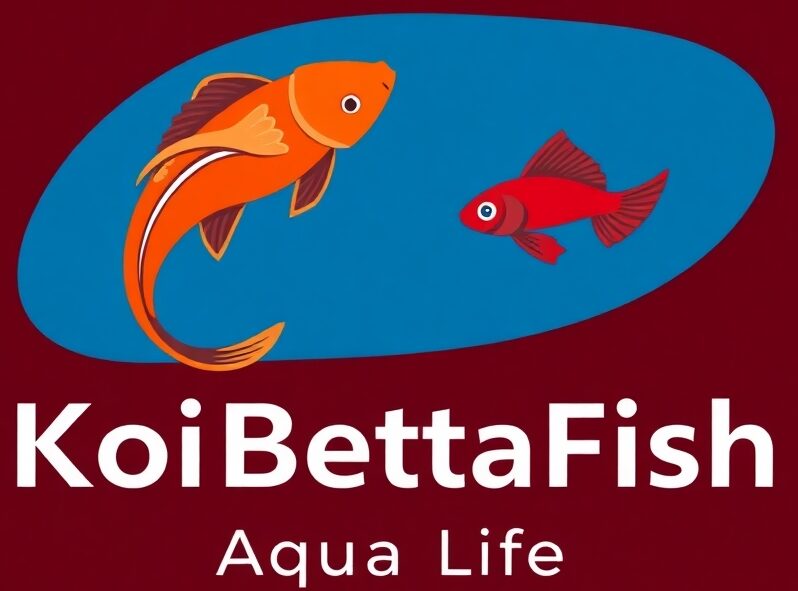Plants in an Aquarium – More Than Just Decoration!
Adding plants in an aquarium isn’t just about making your tank look beautiful – it’s about creating a healthier, more balanced ecosystem for your fish. Live aquatic plants help oxygenate the water, reduce algae growth, and provide natural hiding spots for shy swimmers like Betta fish. Whether you’re a beginner or an aqua scaping enthusiast, choosing the right plants can transform your aquarium into a thriving underwater paradise. In this guide, we’ll explore why plants in an aquarium are a game-changer and how to pick and care for the best ones.
As beginners, you might wonder where to start. Plants in an aquarium help keep the water clean and give your fish a safe place. This guide will teach you how to pick and care for aquatic plants. You’ll learn to create a balanced and beautiful underwater world.
By the end of this article, you’ll know how to pick the best plants for your tank. You’ll also learn how to take care of them. Let’s explore the world of aquarium plants and see how they can make your fishkeeping better!
Key Takeaways
- Understand the benefits of having plants in your aquarium.
- Learn how to choose the right aquatic plants for your tank.
- Discover the basics of caring for your underwater flora.
- Find out how aquarium greenery enhances water quality.
- Get tips on creating a balanced ecosystem in your aquarium.
The Vital Role of Aquatic Greenery in Tank Ecosystems
Aquatic plants do more than look good in your aquarium. They are key to a healthy ecosystem. They help keep your tank balanced and your fish happy.
Ecological Benefits of Live Plants
Live plants in your aquarium are more than just pretty. They are crucial for your fish’s health. Let’s explore their ecological benefits.
Oxygen Production and Carbon Dioxide Consumption
Live plants make oxygen through photosynthesis. They use carbon dioxide in the process. This helps keep your tank’s ecosystem stable, making it healthier for your fish.
Natural Filtration and Waste Processing
Aquatic plants also act as natural filters. They absorb nutrients and waste from the water. This keeps the water clean, reducing the need for frequent water changes.
Visual Impact on Aquarium Aesthetics
Aquatic plants bring nature into your aquarium. They make it look beautiful, enhancing your fish’s beauty. With many shapes, sizes, and colors, you can create a unique look that’s all your own.
| Benefit | Description |
|---|---|
| Oxygen Production | Live plants produce oxygen, enhancing water quality. |
| Natural Filtration | Plants absorb waste and excess nutrients, reducing algae growth. |
| Aesthetic Appeal | Aquatic plants add color and texture, creating a natural environment. |
Adding live plants to your aquarium does more than make it look good. It also makes it a healthier place for your fish to live.
Benefits of Adding Live Plants to Your Aquatic Environment
Adding live plants to your tank is a simple way to improve it. They add natural beauty and help keep the ecosystem balanced.
Water Quality Improvement
Live plants are great for keeping the water clean. They soak up nutrients and waste, making the water clear and healthy.
Nitrate Reduction
They are especially good at lowering nitrate levels. High nitrates can harm fish. Plants help keep the environment stable.
pH Stabilization
Plants also help keep the pH balanced. They absorb CO2 during photosynthesis, preventing sudden pH changes.
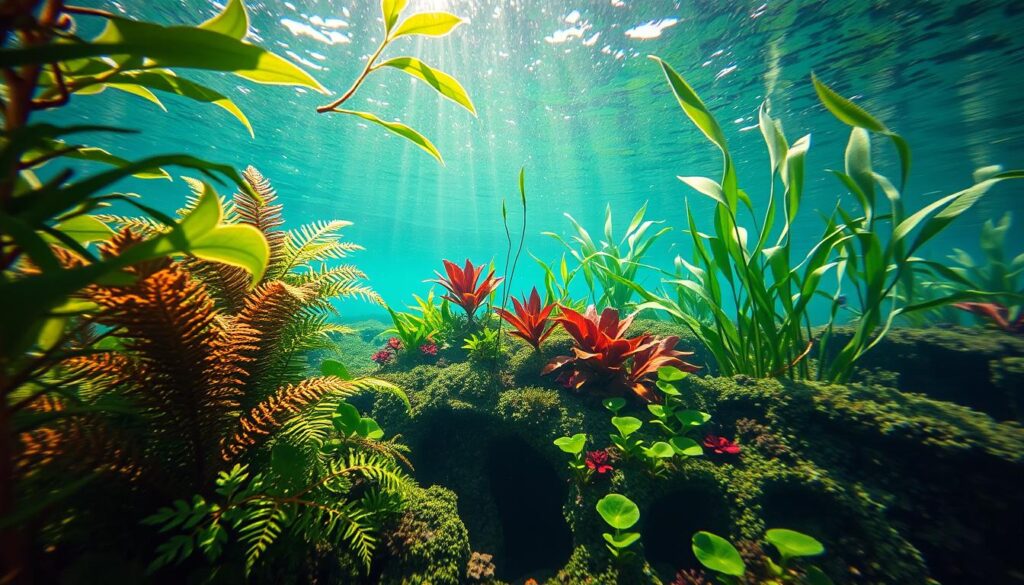
Creating Natural Habitats for Fish
Live plants give fish natural places to hide and breed. This reduces stress and promotes healthy behavior. It makes the tank more engaging for your fish.
Algae Control Through Nutrient Competition
Plants compete with algae for nutrients. This starves algae, reducing the need for chemicals and frequent water changes.
Adding live plants to your planted tank setup boosts health and beauty. With the right aquarium plant nutrients, you can create a thriving underwater garden for you and your fish.
Want to decorate your fish tank?
Check out the Ameliade Aquarium Plant & Rock Cave Set – perfect for goldfish and Betta tanks.
👉 Click here to buy now.
Plants in an Aquarium: Types and Classifications
The world of aquarium plants is vast and diverse. It offers something for every aquarist, from beginners to experts. With a wide range of types of aquarium plants available, creating a beautiful aquarium is fun and rewarding.
Foreground Carpet Plants
Foreground carpet plants add depth and interest to your aquarium. They spread across the substrate, creating a lush carpet effect.
Dwarf Hairgrass and Monte Carlo
Dwarf Hairgrass and Monte Carlo are popular for carpeting. They’re easy to care for and thrive in various lighting conditions.
Midground Statement Plants
Midground plants add height and drama to your aquarium. They draw the eye to the tank’s center.
Cryptocoryne and Hygrophila Varieties
Cryptocoryne and Hygrophila are favorite midground plants. They come in various shapes, sizes, and colors. They’re low-maintenance and tolerate different water conditions.
Background Height Plants
Background plants create depth and serve as a backdrop for other plants and fish.
Stem Plants and Tall Species
Stem plants like Cabomba and Ludwigia add height to your tank’s background. They grow tall and may need regular pruning.
Floating Plants for Surface Coverage
Floating plants add shade and reduce algae in your aquarium. They float on the water’s surface, creating a natural canopy for fish.
| Plant Type | Description | Care Level |
|---|---|---|
| Foreground Carpet Plants | Spread across the substrate, creating a carpet-like effect | Moderate |
| Midground Statement Plants | Add height and drama to the aquarium | Low to Moderate |
| Background Height Plants | Create a sense of depth and provide a backdrop | Moderate to High |
| Floating Plants | Float on the surface, providing shade and reducing algae | Low |
Selecting the Right Plants for Your Tank Size
The size of your aquarium is key to picking the right plants. Whether you have a small nano tank or a big aquarium, choosing the right plants is crucial. It helps create a balanced and beautiful underwater world.
Nano Tank Plant Selection (Under 10 Gallons)
Nano tanks need plants that are small and don’t spread out too much. These tanks require creativity and careful planning to look lush.
Space-Efficient Species
For nano tanks, think about plants like Java Moss, Dwarf Hairgrass, or Micro Swords. They are small and add a vibrant green color to your tank.
Medium Tank Options (10-30 Gallons)
Medium tanks give you more freedom in choosing plants. You can mix different species to add depth and interest.
Balancing Variety with Scale
In medium tanks, you can have a variety of plants. Use foreground plants like Cuboxyphyte or Dwarf Mondo Grass. Midground plants like Anubias or Cryptocorynes add layers and make your tank more engaging.
Large Aquarium Planting Strategies (30+ Gallons)
Large aquariums are perfect for creating complex landscapes. You can use a wide range of plants to make your tank stand out.
Creating Depth and Perspective
For large tanks, mix tall background plants like Amazon Swords or Vallisneria. Use midground plants like Crypts or Anubias. Add foreground plants like Glossostigma or Dwarf Hairgrass. This layering adds depth and beauty to your tank.

Choosing the right plants for your tank size is important. It helps create a thriving and beautiful aquarium. Remember, balance your plant selection with your tank’s size to ensure your underwater garden thrives.
Beginner-Friendly Aquarium Plants: Where to Start
If you’re new to aquarium plants, don’t worry. We’ve got some easy options for you. Starting with simple plants is key to a healthy aquarium.
Low-Maintenance Rhizome Plants
Rhizome plants are easy to care for. They can grow well in different conditions. Let’s look at some popular ones.
Java Fern Varieties
Java Fern is loved by many for its toughness and flexibility. It can stick to rocks or driftwood. It also works well in various light levels.
Anubias Species
Anubias plants are easy to care for. They do well in low light, making them perfect for dimly lit tanks. They add beauty to your aquarium.
Hardy Rosette Plants
Rosette plants have beautiful, symmetrical leaves. They’re easy to care for and can grow in different conditions.
Amazon Sword
The Amazon Sword is a favorite for its striking look and low care needs. It likes nutrient-rich soil and moderate to bright light.
Vallisneria Species
Vallisneria is versatile and hardy. It grows well in various light levels. It adds height and interest to your tank.
Easy Moss Varieties
Mosses create a natural, lush look in your aquarium. Let’s explore some easy-to-care-for moss types.
Java Moss and Christmas Moss
Java Moss and Christmas Moss are easy to care for. They thrive in different light levels. They’re great for a mossy look in your aquarium.
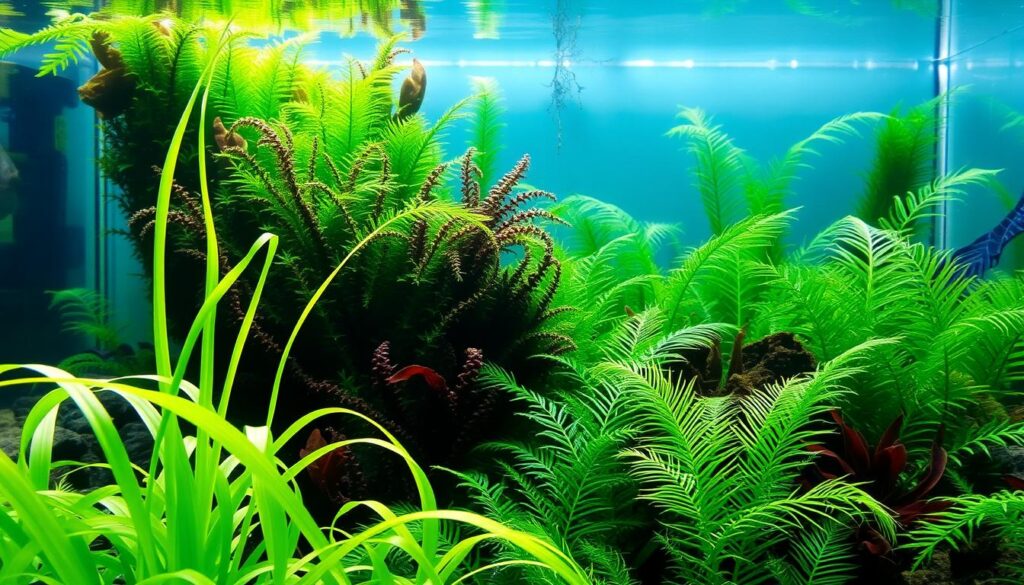
| Plant Type | Lighting Requirements | Care Level |
|---|---|---|
| Java Fern | Low to High | Easy |
| Anubias | Low | Easy |
| Amazon Sword | Moderate to High | Moderate |
| Vallisneria | Low to High | Easy |
| Java Moss | Low to High | Easy |
Essential Tools and Equipment for Planted Tanks
Creating a beautiful planted tank is more than just picking plants. You also need the right tools. To keep your tank healthy, you must invest in key equipment.
Planting Tools and Accessories
For planting, the right tools are crucial. You’ll need:
- Tweezers and Scissors for precise planting and trimming.
- Plant Weights and Anchors to keep plants steady.
Maintenance Equipment
Regular care is vital for a healthy tank. You’ll need:
- Algae Scrapers and Cleaning Tools to keep the glass clear.
Monitoring Devices
To keep your tank balanced, you must check water parameters often. Water Parameter Test Kits are very helpful for this.
Here’s a quick list of the must-have tools and equipment for planted tanks:
| Tool/Equipment | Purpose |
|---|---|
| Tweezers and Scissors | Precision planting and trimming |
| Plant Weights and Anchors | Securing plants in place |
| Algae Scrapers and Cleaning Tools | Cleaning tank glass |
| Water Parameter Test Kits | Monitoring water quality |
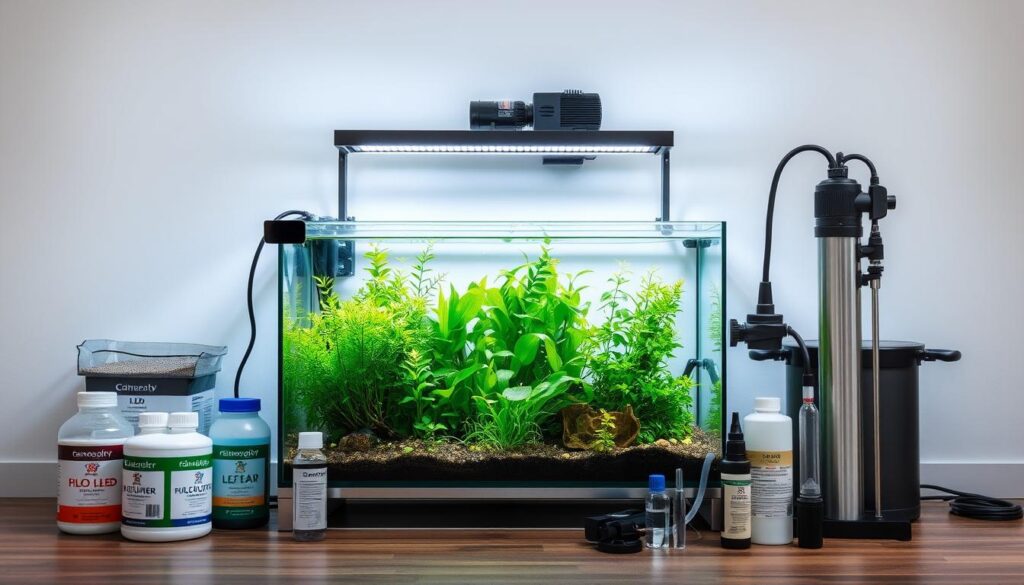
By getting these essential tools and equipment, you’re on your way to a thriving planted tank. It will bring joy and peace to your space.
Substrate Options for Thriving Aquatic Plants
Let’s explore the world of substrates and find the best one for your aquatic plants. The right substrate is crucial for your plants’ health. It offers nutrients and supports root growth.
Specialized Plant Substrates
Specialized substrates are made for aquatic plants. They provide a nutrient-rich environment. This helps plants grow strong roots and thrive.
Aquasoil and Nutrient-Rich Options
Aquasoil is a favorite among aquarists for its nutrient content. It supports beneficial bacteria too. As John H. said, “A good substrate is like a good foundation for a house; it determines how well everything else will work.” Choosing the right aquasoil can be a game-changer for your tank!
Budget-Friendly Alternatives
Not everyone wants to spend a lot on substrates. Luckily, there are affordable options that work well.
Gravel and Sand Combinations
Gravel and sand together make a nice substrate. It helps with water flow and root growth. Aquarists say, “A well-designed substrate mix can enhance the overall aesthetic of the tank while supporting plant health.”
Dirted Tank Methodology
The dirted tank method uses soil or dirt as the substrate. It’s often topped with sand or gravel. This method is great for plant growth.
Soil Capping Techniques
Soil capping layers soil under a cap of sand or gravel. It prevents water cloudiness while giving plants nutrients.
“Soil capping is a clever way to utilize the benefits of soil without the drawbacks,” says Jane D., an experienced aquarist.

In conclusion, the right substrate is key for your plants’ health. You can choose specialized substrates, affordable options, or the dirted tank method. The most important thing is to pick a substrate that meets your plants’ needs.
Lighting Requirements for Healthy Growth
Lighting is key to a lush aquarium. It helps plants grow through photosynthesis. But, picking the right light can be tough.
Understanding Light Intensity and Spectrum
Light intensity and spectrum are crucial. Intensity is how much light is emitted. Spectrum is the light’s color. Plants need specific light types to thrive.
PAR Values and Plant Needs
PAR values measure light for photosynthesis. Plants need different PAR levels. For example, Java Moss needs 10-20 PAR, while Hemianthus micranthemoides needs 50 or more.
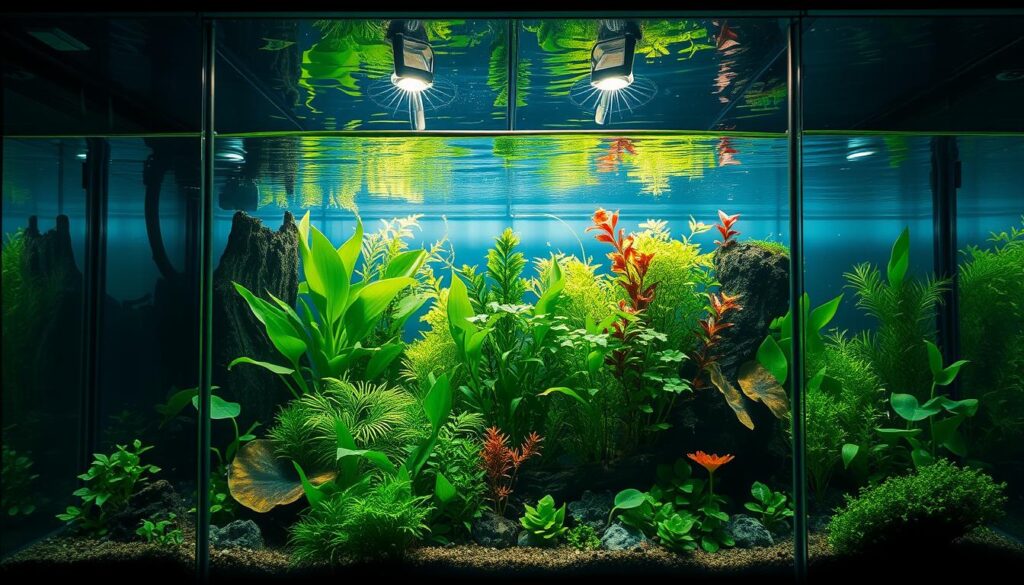
Photoperiod Management
Managing the lighting cycle is important. A good cycle promotes plant growth and prevents algae. Most tanks do well with 8-10 hours of light daily.
Timer Setup and Light Scheduling
To control your lighting, use a timer. You can choose simple or smart timers. This ensures a consistent environment for your plants.
Budget vs. High-End Lighting Solutions
You don’t need to spend a lot for good lighting. T5 and T8 lights are affordable. LEDs, though pricier, offer energy savings and customization.
LED Options for Different Tank Sizes
LEDs are versatile for aquariums. Small tanks use compact LEDs, while large tanks need extensive systems. Choose based on your tank size and plant needs.
Understanding your lighting options helps create a vibrant aquarium. Choose wisely to showcase your plants beautifully!
Fertilization Strategies for Vibrant Plants
Fertilizing your aquarium plants is like giving them a nutrient-rich smoothie. It’s essential for their growth and vibrancy. To keep your plants thriving, you need to provide them with the right nutrients. There are several fertilization strategies to achieve this.
Root Feeding Methods
Root feeding involves delivering nutrients directly to the roots of your plants. This method is particularly effective for plants with a robust root system.
Water Column Fertilization
Water column fertilization involves adding nutrients directly to the water. This method is beneficial for plants that absorb nutrients through their leaves.
CO2 Supplementation Basics
CO2 supplementation is crucial for promoting healthy plant growth. By increasing the CO2 levels in your tank, you can enhance photosynthesis and encourage your plants to thrive.
By implementing the right fertilization strategy, you can enjoy vibrant, healthy plants. They add beauty and life to your aquarium. Experiment with different methods to find what works best for you and your aquatic friends!
Planting Techniques and Best Practices
To keep your aquatic plants thriving, learning the basics is key. Proper planting techniques are vital for healthy plants in your aquarium.
Preparing New Plants
Before adding new plants, they need to be ready. This means quarantining, trimming, and cleaning them.
Quarantine Procedures
Quarantining new plants stops pests and diseases from entering your tank. Keep them separate for a few weeks and watch for any issues.
Trimming and Cleaning
Removing dead leaves and cleaning the roots helps prevent decay. It also encourages healthy growth. It’s like giving your plants a new beginning!
Proper Planting Methods by Plant Type
Different plants have unique needs. For stem plants, gently place the stem in the substrate, avoiding buried leaves. For rhizome plants, attach them to rocks or driftwood to keep them anchored.
Stem Plant Insertion
When planting stem plants, make sure the substrate covers the lower nodes. This is where roots will grow.
Rhizome Attachment Techniques
Secure rhizome plants to a substrate or decoration. This prevents them from floating away.
Creating Effective Plant Groupings
Grouping plants can make your aquarium look better and help them grow. Use layers with foreground, midground, and background plants.
| Plant Type | Planting Method | Benefits |
|---|---|---|
| Stem Plants | Insert into substrate | Promotes root growth |
| Rhizome Plants | Attach to rocks or driftwood | Prevents floating away |
| Floating Plants | Place on water surface | Provides shade and reduces algae |
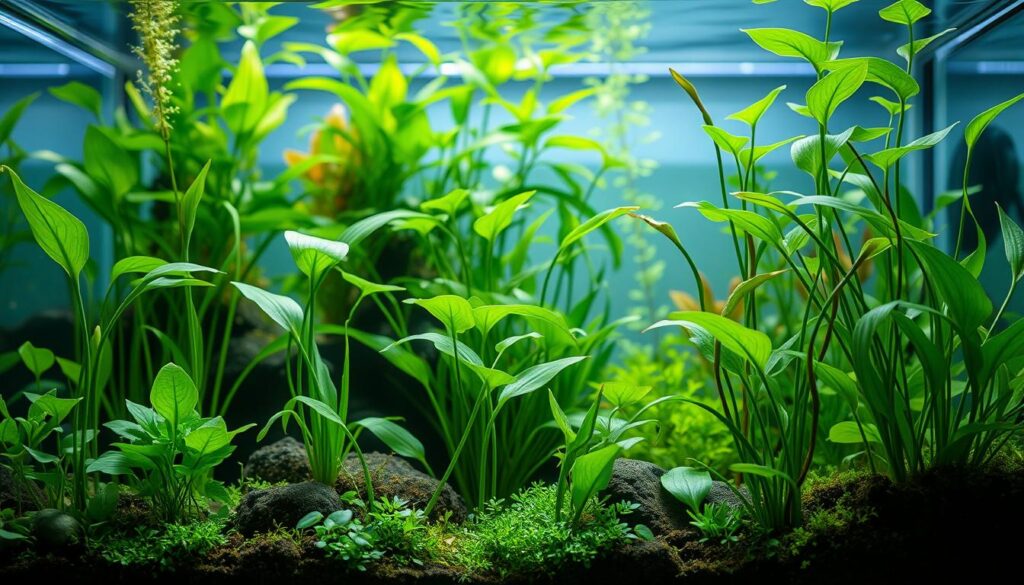
Maintenance Schedule for Long-Term Success
Creating a regular maintenance schedule is key for your aquarium’s long-term health. It keeps your aquarium thriving and healthy. We’re here to help you set it up!
Daily and Weekly Tasks
Daily and weekly tasks are the heart of aquarium care. Spending a few minutes each day and some time on weekends keeps your aquarium stable. It also keeps your fish healthy.
Visual Inspections
Do a quick visual check daily. Look for signs of stress in your fish, unusual algae, or equipment issues. It’s a simple habit that can catch problems early.
Water Parameter Monitoring
Check your water parameters weekly. Look at pH, ammonia, nitrite, and nitrate levels. This keeps your aquarium healthy and lets you make needed adjustments. Use kits and devices to make it easier and more accurate.
Monthly Maintenance Routines
Monthly tasks are important for your aquarium’s health and look. They’re a bit more involved but crucial for success.
Fertilization Adjustments
Change your fertilization plan monthly. Some plants need more nutrients at certain times. Watch and adjust as needed.
Major Pruning Sessions
Prune your plants monthly. It keeps them looking good and growing well. It’s also a chance to propagate new plants or remove dead ones.
Seasonal Considerations
Seasonal changes affect your aquarium’s temperature and environment. Knowing this helps you make the right adjustments.
Temperature Fluctuations
Watch for temperature changes with the seasons. Adjust your heater or chiller to keep a stable temperature. This is vital for your fish and plants’ health.
By sticking to this maintenance schedule, you’ll have a thriving and beautiful aquarium. Remember, being consistent is important. With practice, these tasks will become easy!
Pruning and Propagation Methods
To keep your aquarium plants healthy and thriving, mastering pruning and propagation techniques is key! Regular pruning keeps your aquarium looking great and helps plants grow well.
Trimming Techniques by Plant Category
Each plant type needs its own pruning method. For example, stem plants need topping to grow bushy. Rosette plants must have dead leaves removed to stay healthy.
Stem Plant Topping
Stem plants like Ludwigia and Hygrophila benefit from regular topping. Cutting off the top encourages branching, making the plant fuller.
Rosette Plant Maintenance
Rosette plants, like Echinodorus, need careful care. Remove dead or dying leaves to keep the plant healthy and looking good.
Propagation Strategies
Propagation is a wonderful way to share plants or add to your tank. You can use runner plants or divide rhizomes.
Runner Plants
Plants like Vallisneria and Sagittaria produce runners. These can be easily separated and replanted. Just cut the runner from the mother plant and plant it in your substrate.
Rhizome Division
For plants with rhizomes, like Anubias, division is simple. Carefully separate the rhizome, making sure each section has roots and leaves. Then, replant them.
Replanting Cuttings Successfully
When replanting cuttings, ensure they’re planted at the right depth. Also, provide enough light and nutrients. With the right care, your cuttings will grow into healthy plants!
Common Aquarium Plant Problems and Solutions
As an aquarium enthusiast, you might face some common plant issues. But don’t worry, we’ve got you covered! Let’s explore some common problems and how to solve them.
Identifying Nutrient Deficiencies
Nutrient deficiencies can harm your plants. Watch for yellow leaves or slow growth. These signs often mean your plants need more nutrients.
Leaf Symptoms and Diagnosis
Leaf symptoms can tell you a lot. For example, yellow leaves might mean a lack of nitrogen. Purple or reddish leaves could point to phosphorus deficiency. Knowing the issue helps you fix it.
Combating Algae Issues
Algae can be a problem in aquariums. They compete with plants for nutrients and look bad. Regular water changes and proper lighting can help control algae.
Types of Algae and Targeted Treatments
Each type of algae needs a different approach. For example, green algae can be managed with more water flow and less nutrients. Black beard algae might need special treatments like algae-eating fish or chemicals.
Melting Plants and Recovery Strategies
Plants can “melt” when introduced to a new aquarium. This usually happens because of acclimation challenges.
Acclimation Challenges
To avoid melting, acclimate your plants slowly to their new home. Keep a close eye on water conditions.
Reviving Struggling Plants
If your plants are struggling, check for nutrient deficiencies or algae. Fixing these issues can help your plants recover and flourish.
Balancing Plants with Tank Inhabitants
Creating a thriving aquarium ecosystem is all about balance. You need to think about both your plants and fish. This way, you can make a peaceful environment for everyone.
Plant-Compatible Fish Species
Choosing the right fish is key. Some fish can harm your plants, while others live in harmony.
Non-Destructive Community Fish
Choosing non-destructive fish is smart. This keeps your plants healthy. Here are some good picks:
- Neon Tetras: These small fish are gentle and colorful.
- Harlequin Rasboras: Peaceful and active, they’re easy to care for.
- Corydoras Catfish: They clean up food and are gentle on plants.
Beneficial Invertebrates for Planted Tanks
Some invertebrates are great for your tank. They help with algae and add interest.
Shrimp and Snail Species
Shrimp and snails are good for your tank. Here are some favorites:
- Amano Shrimp: They eat algae well.
- Nerite Snails: Good at eating algae and easy to care for.
Appropriate Stocking Levels
Choosing the right fish and invertebrates is important. But, you also need to think about stocking levels.
Bioload Considerations
Understanding bioload is key. Bioload is the waste your tank’s inhabitants produce. Too much can harm water quality. So, it’s vital to match the number of inhabitants to your tank’s size.
To keep your tank balanced, remember these tips:
- Check your tank’s water often.
- Don’t overfeed to avoid too much waste.
- Change the water regularly to keep it clean.
By balancing plants and inhabitants, and watching stocking levels, you can have a beautiful, thriving aquarium. It will bring you joy and peace.
Advanced Aquascaping with Aquatic Plants
Creating a beautiful aquascape is a journey that combines creativity, patience, and a passion for aquatic life. As you dive into the world of advanced aquascaping, you’ll discover various styles and techniques. These will help transform your aquarium into a stunning visual masterpiece.
Nature Aquarium Style
The Nature Aquarium style, popularized by Takashi Amano, focuses on creating a natural environment. It uses a mix of plants, rocks, and driftwood to mimic a miniature ecosystem.
Focal Points and Golden Ratio
To create a visually appealing aquascape, use the golden ratio. Position striking rocks or specimen plants as focal points within the tank.
Dutch Aquarium Approach
The Dutch Aquarium approach showcases a variety of plant species in a structured way. It uses different plant heights and colors to create a layered effect.
Street and Row Planting
In the Dutch style, plants are arranged in ‘streets’ or rows. This creates a sense of depth and order within the aquascape.
Iwagumi and Minimalist Designs
Iwagumi designs, inspired by Japanese rock gardens, feature rocks as the main attraction. Plants play a supporting role, creating a serene and balanced aquascape.
Rock Placement with Plant Accents
Careful rock placement is crucial in Iwagumi designs. Plants are used to accentuate the rocks and add subtle color to the aquascape.
Let’s take a look at a comparison of these styles:
| Style | Key Features | Plant Usage |
|---|---|---|
| Nature Aquarium | Recreates natural environments | Varied, with emphasis on natural growth |
| Dutch Aquarium | Structured, layered planting | Multiple species, arranged in rows |
| Iwagumi | Rock-centric, minimalist | Plants used as accents |
Conclusion: Growing Success with Aquarium Plants
With the right knowledge and techniques, you can create a thriving underwater garden! You now know the basics of aquarium plant care. This includes choosing the right plants for your tank size and mastering fertilization strategies.
Success in your planted tank journey comes from balance and attention to detail. Keep your underwater garden thriving by sticking to a routine. Also, monitor your tank’s conditions and make adjustments as needed.
Whether you’re new to aquarium plant care or have been doing it for a while, the key is patience and persistence. Dive in, get creative, and enjoy the many rewards of aquarium plant care!
